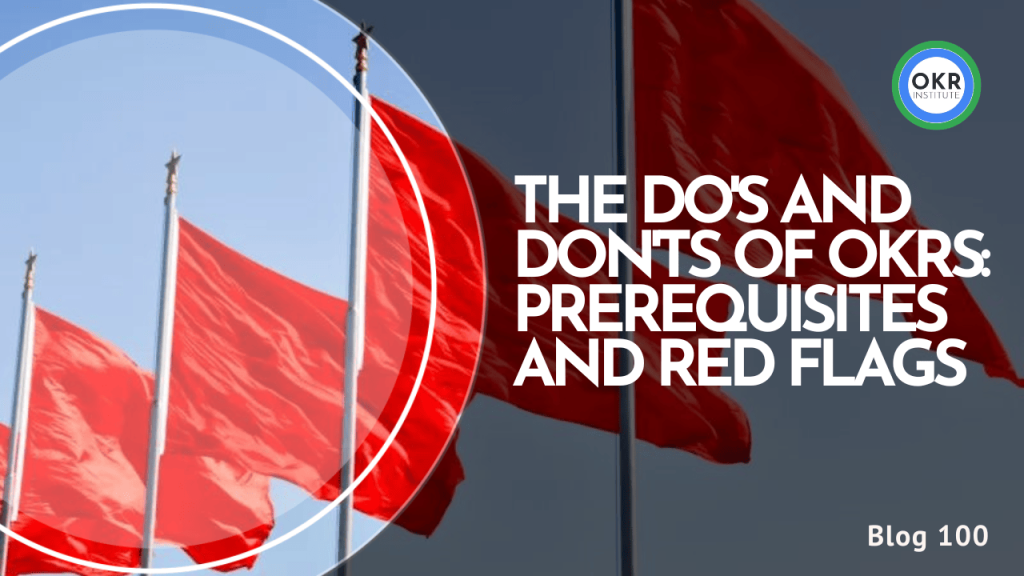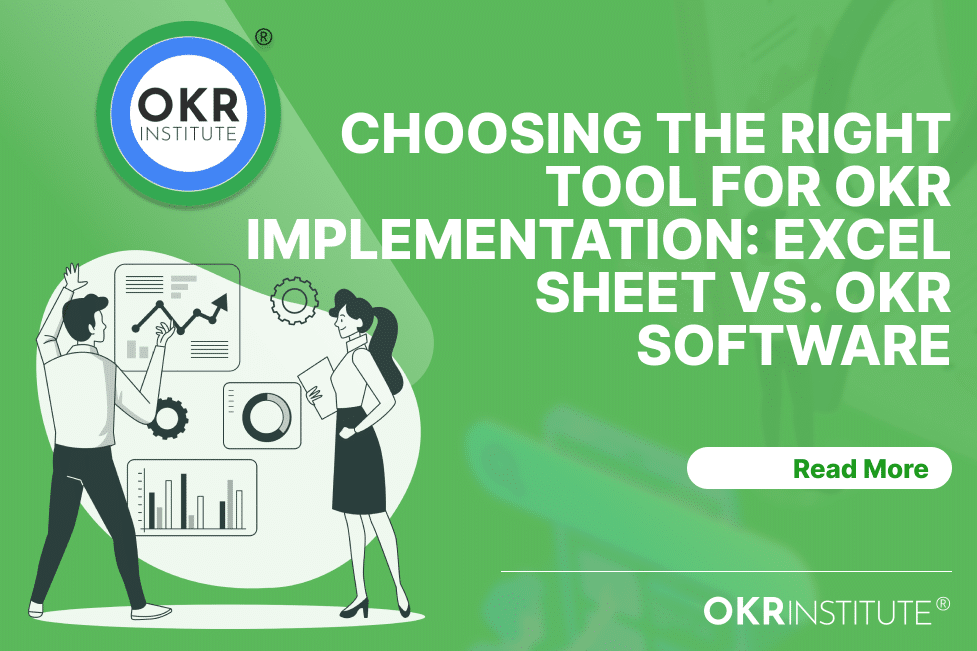The Do’s and Don’ts of OKR: Prerequisites and Red Flags

Why OKRs Matter for Sustainable Goal Setting
Objectives and Key Results (OKRs) have emerged as a powerful goal-setting framework for organizations seeking to align teams, drive focus, and achieve ambitious outcomes. At their core, OKRs provide a structured approach to defining measurable objectives and tracking progress through quantifiable key results. This methodology empowers teams to collaborate effectively, prioritize efforts, and maintain transparency throughout the goal-setting process.
The true power of OKRs lies in their ability to foster organizational alignment and accountability. By cascading objectives from the top down, teams at every level can understand how their efforts contribute to the broader organizational goals. This alignment ensures that everyone is working towards a common purpose, minimizing siloed efforts and maximizing impact.
However, implementing OKRs is not a one-size-fits-all solution. For a sustainable OKR adoption, organizations must cultivate a culture of trust, transparency, and committed leadership. Conversely, environments characterized by command-and-control management styles or an overreliance on OKRs for every aspect of work can undermine the effectiveness of this goal-setting framework.
In this comprehensive guide, we will explore the prerequisites and red flags that organizations must navigate to achieve a successful and sustainable OKR implementation. By understanding the critical factors that enable or hinder OKR success, leaders can proactively address potential challenges and create an environment where OKRs can thrive, driving tangible results and fostering a culture of continuous improvement.
Prerequisite 1: Building a Culture of Trust
Trust is the bedrock of a successful OKR implementation. Without trust, teams will be hesitant to openly communicate, embrace failure, and continuously improve. A culture of trust fosters an environment where individuals feel safe to share ideas, experiment, and learn from mistakes without fear of repercussions.
Open communication is essential for OKRs to thrive. When team members trust each other, they can have candid discussions about progress, challenges, and areas for improvement. This open dialogue enables course corrections, resource reallocations, and collaborative problem-solving, ultimately leading to better outcomes.
Embracing failure is also crucial for continuous improvement. In a trusting environment, teams can acknowledge failures without blame, analyze what went wrong, and use those insights to refine their approach. Failure becomes a learning opportunity rather than a source of shame or punishment.
Moreover, a culture of trust empowers individuals to take calculated risks and think outside the box. When team members feel secure, they are more likely to propose innovative ideas and challenge the status quo, driving continuous improvement and growth.
Building trust requires conscious effort from leaders and team members alike. Leaders must model vulnerability, admit mistakes, and create a safe space for open dialogue. Team members must actively listen, respect differing perspectives, and support one another’s growth. By cultivating trust, organizations can unlock the full potential of OKRs and foster a cycle of continuous learning and adaptation.
Prerequisite 2: Committed Leadership
Committed leadership is essential for the successful implementation and sustained adoption of OKRs within an organization. Leaders play a crucial role in promoting the OKR philosophy, modeling the desired behavior, and providing the necessary support to ensure OKRs become an integral part of the company’s goal-setting and performance management processes.
Effective leaders understand that OKRs are not just another management fad but a powerful tool for aligning teams, fostering transparency, and driving focus on the most important priorities. They lead by example, setting ambitious yet achievable OKRs for themselves and their teams, and actively participating in the OKR planning, execution, and review cycles.
Moreover, committed leaders recognize the importance of continuous learning and adaptation. They encourage open dialogue, seek feedback, and are willing to make adjustments to the OKR process based on the organization’s evolving needs and lessons learned. This iterative approach not only enhances the effectiveness of OKRs but also reinforces the culture of continuous improvement.
In addition to championing the OKR methodology, committed leaders provide the necessary resources and support to ensure its successful implementation. This includes allocating dedicated time for OKR planning, providing training and coaching, and fostering an environment that celebrates both successes and failures as learning opportunities.
Ultimately, committed leadership is the driving force behind the sustainable adoption of OKRs. When leaders embody the OKR principles and actively support their teams, it creates a ripple effect throughout the organization, fostering a culture of focus, accountability, and continuous improvement – the hallmarks of a successful OKR implementation.
Red Flag 1: Command and Control Culture
A command and control management style is one of the biggest red flags that can undermine the successful adoption and sustained engagement with OKRs. This top-down, rigid approach to leadership is antithetical to the core principles of OKRs, which emphasize transparency, collaboration, and employee empowerment.
In a command and control culture, decisions are made at the top levels of the organization, and employees are expected to follow orders without question or input. This hierarchical structure stifles the free flow of ideas and feedback, which is essential for OKRs to thrive. When employees are not given a voice in setting their own goals or contributing to the broader organizational objectives, they are less likely to feel invested in the process or motivated to achieve those goals.
Moreover, a command and control culture often breeds fear and mistrust, as employees may feel that their performance is constantly being scrutinized and that failure is not tolerated. This atmosphere of pressure and anxiety can lead to a focus on meeting arbitrary targets rather than driving meaningful progress and innovation. OKRs are meant to be ambitious and aspirational, but in a command and control environment, employees may be tempted to set overly conservative goals to avoid potential repercussions.
Effective OKR implementation requires a culture of psychological safety, where employees feel comfortable taking risks, experimenting, and learning from failures. In a command and control culture, however, failures are often punished rather than viewed as opportunities for growth and improvement. This can lead to a risk-averse mindset that stifles creativity and innovation – the very qualities that OKRs are designed to foster.
Ultimately, a command and control culture is fundamentally at odds with the principles of transparency, collaboration, and employee empowerment that are essential for successful OKR adoption and sustained engagement. Organizations that embrace this rigid, top-down management style are likely to face significant challenges in implementing OKRs in a meaningful and sustainable way.
Red Flag 2: Overusing OKRs
One of the biggest pitfalls organizations face when implementing OKRs is the temptation to apply them to every aspect of work. While OKRs are a powerful tool for goal-setting and alignment, they are not a panacea for all organizational challenges. Attempting to use OKRs for every task, project, and initiative can quickly lead to a lack of focus and prioritization, undermining the very purpose of the OKR framework.
The true strength of OKRs lies in their ability to concentrate efforts on the most critical objectives. By carefully selecting a handful of key priorities, teams can channel their energy and resources toward achieving those goals. Overloading the system with too many OKRs dilutes their impact and creates a sense of overwhelm, leading to a lack of meaningful progress.
Moreover, not every task or activity within an organization requires the rigorous tracking and measurement that OKRs demand. Trying to apply OKRs to routine operational tasks or low-priority initiatives can create unnecessary bureaucracy and administrative overhead, draining valuable time and resources away from more strategic endeavors.
Effective OKR implementation requires a judicious approach, striking a balance between ambition and feasibility. Organizations should carefully evaluate which areas of their work are most critical and would benefit the most from the focus and alignment that OKRs provide. By selectively applying OKRs to the highest-leverage initiatives, organizations can maximize their impact while avoiding the pitfalls of overuse and dilution.
Building Trust through Transparency and Psychological Safety
Trust is the bedrock of a successful OKR implementation. It fosters open communication, empowers teams to take risks, and creates a safe environment for failure and learning. Building trust requires a deliberate effort towards transparency and cultivating psychological safety.
Embrace Radical Transparency: Encourage open and honest communication at all levels. Share information freely, including challenges, setbacks, and failures. Celebrate both successes and lessons learned. Transparency builds trust and aligns teams towards common goals.
Lead by Example: Leaders must model vulnerability and transparency. Admit mistakes, share personal experiences, and acknowledge areas for growth. This sets the tone for a culture of trust and psychological safety.
Create Safe Spaces: Establish forums and channels where teams can voice concerns, ask questions, and challenge assumptions without fear of repercussions. Encourage constructive feedback and dissenting opinions, as they often lead to better solutions.
Celebrate Failures: Reframe failures as learning opportunities. Encourage teams to experiment, take calculated risks, and share their failures openly. Celebrate the lessons learned and the courage to try new approaches.
Foster Psychological Safety: Cultivate an environment where team members feel comfortable expressing themselves without fear of embarrassment, rejection, or punishment. Actively listen, show empathy, and respond constructively to concerns or mistakes.
By prioritizing transparency and psychological safety, organizations can build a foundation of trust that empowers teams to embrace OKRs fully. This trust enables open communication, risk-taking, and continuous learning, ultimately driving sustainable goal achievement.
Cultivating Committed Leadership for OKR Success
Effective leadership is pivotal for the successful adoption and sustained implementation of OKRs within an organization. Leaders must embody the values and behaviors they wish to cultivate, serving as role models for the entire team. A committed leader understands that OKRs are not merely a top-down directive but a collaborative process that requires active participation and engagement from all levels of the organization.
Qualities of an effective OKR leader include:
- Clarity of Vision: A leader must have a clear and compelling vision for the organization’s goals and how OKRs can help achieve them. They should be able to articulate this vision in a way that inspires and aligns the team.
- Transparency and Open Communication: OKR leaders foster an environment of trust and transparency by openly sharing information, seeking feedback, and encouraging open dialogue. They create a safe space for team members to voice concerns, ask questions, and contribute ideas.
- Coaching and Empowerment: Rather than dictating objectives and key results, effective leaders coach and empower their teams to develop meaningful OKRs that align with the organization’s strategic goals. They provide guidance and support while allowing teams to take ownership and accountability for their OKRs.
- Continuous Learning and Adaptation: Leaders must be willing to learn and adapt as the OKR process evolves. They should actively seek feedback, embrace lessons learned, and make necessary adjustments to ensure the sustainability and effectiveness of the OKR implementation.
Best practices for leading by example and supporting teams include:
- Actively Participating in OKR Setting: Leaders should be involved in the OKR development process, collaborating with teams to ensure alignment and offering their expertise and insights.
- Regular Check-ins and Progress Updates: Conducting regular check-ins and progress updates not only holds teams accountable but also provides opportunities for leaders to offer support, remove roadblocks, and celebrate successes.
- Recognizing and Rewarding Progress: Leaders should acknowledge and celebrate both individual and team achievements, fostering a culture of continuous improvement and motivation.
- Modeling Accountability and Ownership: By taking accountability for their own OKRs and demonstrating a commitment to achieving them, leaders inspire others to do the same, reinforcing a sense of ownership and responsibility throughout the organization.
- Providing Resources and Support: Effective leaders ensure that teams have the necessary resources, training, and support to successfully implement and achieve their OKRs, removing potential barriers to success.
By cultivating committed leadership and embodying the qualities and best practices outlined above, organizations can create an environment conducive to sustainable OKR implementation, where teams are empowered, aligned, and motivated to achieve ambitious goals.
Avoiding the Command and Control Trap
A command and control culture is one of the biggest red flags that can undermine the effectiveness of OKRs. In such environments, decision-making is centralized, and employees are expected to follow orders without questioning or providing input. This top-down approach stifles collaboration, innovation, and the very essence of what OKRs are meant to achieve.
Signs of a Command and Control Culture:
- Rigid hierarchies and strict adherence to chains of command
- Lack of transparency and open communication
- Micromanagement and close monitoring of employee actions
- Punitive measures for deviating from prescribed processes
- Resistance to change and new ideas from lower levels
To transition to a more collaborative approach, organizations must actively work to dismantle the command and control mindset. This requires a cultural shift that empowers employees, fosters open dialogue, and encourages experimentation.
Strategies for Transitioning to a Collaborative Approach:
- Flatten hierarchies: Reduce unnecessary layers of management and encourage cross-functional collaboration.
- Embrace transparency: Share information openly, including goals, progress, and challenges.
- Foster psychological safety: Create an environment where employees feel comfortable voicing concerns and ideas without fear of retribution.
- Decentralize decision-making: Empower teams and individuals to make decisions that align with organizational goals.
- Encourage continuous learning: Promote a growth mindset and provide opportunities for professional development.
- Lead by example: Leaders must embody the values of collaboration, trust, and open communication.
By actively addressing the command and control tendencies, organizations can create an environment conducive to the successful implementation and sustained use of OKRs. This cultural shift requires commitment from leadership and a willingness to embrace new ways of working that prioritize collaboration, transparency, and employee empowerment.
Finding the Right Balance: OKRs as a Focus Tool
OKRs are powerful tools for aligning teams and individuals with organizational priorities, but they should not be used for every single task or initiative. Overusing OKRs can lead to goal proliferation, diluting their impact and overwhelming teams with too many priorities.
When determining the appropriate scope for OKRs, it’s crucial to align them with your organization’s strategic priorities. OKRs should be reserved for the most important, high-impact objectives that drive your company’s mission and vision forward. These objectives should be ambitious yet achievable, stretching teams to reach new heights while remaining within the realm of possibility.
A common guideline is to limit the number of OKRs to a manageable few, typically three to five objectives per team or individual. This focus allows teams to dedicate their energy and resources to the most critical areas, rather than spreading themselves too thin across numerous initiatives.
Additionally, it’s important to distinguish between OKRs and routine tasks or operational activities. OKRs should represent significant, transformative goals that push the organization forward, while routine tasks can be managed through other means, such as project management tools or standard operating procedures.
By carefully curating the scope of OKRs and aligning them with strategic priorities, organizations can maintain a clear focus, foster alignment, and maximize the impact of their goal-setting efforts.
Case Studies: Organizations That Got it Right (and Wrong)
Successful OKR Implementation: Spotify
Spotify is often hailed as a prime example of successful OKR implementation. The music streaming giant embraced OKRs as a way to align its rapidly growing workforce around shared goals. By fostering a culture of transparency and trust, Spotify empowered teams to set their own OKRs, which were then reviewed and vetted by leadership. This bottom-up approach ensured buy-in and ownership at all levels, while maintaining strategic alignment.
Spotify also recognized the importance of not overusing OKRs. They limited the number of OKRs per team and encouraged teams to focus on their most critical objectives. This prevented OKR fatigue and helped maintain the system’s effectiveness as a prioritization tool.
Unsuccessful OKR Implementation: Sears
On the other hand, Sears’ experience with OKRs serves as a cautionary tale. The once-iconic retailer attempted to implement OKRs in a top-down, command-and-control manner, with little buy-in from employees. OKRs were imposed on teams without proper training or understanding, leading to resistance and a lack of ownership.
Furthermore, Sears made the mistake of using OKRs for everything, from high-level strategic goals to granular tasks. This diluted the system’s effectiveness and led to OKR fatigue. Employees felt overwhelmed and disengaged, and the OKR implementation ultimately failed to drive meaningful change or alignment.
Lessons Learned
These case studies highlight the importance of fostering a culture of trust, transparency, and committed leadership when implementing OKRs. Organizations that involve employees in the process, provide proper training, and use OKRs judiciously as a focus tool are more likely to experience success. Conversely, those that attempt to force OKRs in a command-and-control manner or overuse them risk disengagement and failure.
Putting it All Together: A Roadmap for Sustainable OKR Adoption
Implementing OKRs in a sustainable way requires a thoughtful and intentional approach that addresses the prerequisites and avoids the red flags. Here’s a step-by-step roadmap to help you navigate the process:
- Assess your organizational culture: Before diving into OKRs, take a critical look at your organizational culture. Is there a foundation of trust and psychological safety? Are leaders committed to transparency and empowerment? If not, focus on building these essential elements first.
- Secure leadership buy-in: OKRs won’t succeed without unwavering support from top leadership. Educate leaders on the principles and benefits of OKRs, and ensure they’re ready to model the behaviors required for success, such as embracing failure, encouraging risk-taking, and fostering accountability.
- Establish a dedicated OKR team: Identify a cross-functional team responsible for driving the OKR implementation. This team should receive comprehensive training on OKR best practices and serve as champions for the initiative across the organization.
- Start small and focused: Resist the temptation to apply OKRs to every aspect of your organization from the outset. Begin with a pilot program in a specific department or team, allowing you to learn, refine your approach, and demonstrate early wins.
- Provide comprehensive training: Ensure everyone involved in the OKR process receives thorough training on setting effective OKRs, tracking progress, and engaging in productive conversations around them. This will help prevent misuse and maintain focus.
- Integrate OKRs into existing processes: Rather than treating OKRs as a separate initiative, integrate them into your existing goal-setting, performance management, and operational processes. This will increase adoption and reinforce their importance.
- Foster continuous improvement: Regularly review and refine your OKR practices based on feedback and lessons learned. Celebrate successes, but also identify areas for improvement and adjust accordingly.
- Maintain focus and discipline: OKRs are a powerful tool, but they can quickly become diluted if applied too broadly or without discipline. Resist the urge to overuse them, and maintain a clear separation between OKRs and other operational tasks.
- Reinforce the culture: As you progress with OKRs, continuously reinforce the underlying culture of trust, transparency, and empowerment. Recognize and reward behaviors that align with these values, and address any instances of command-and-control tendencies.
- Celebrate and share success stories: As you achieve wins through your OKR implementation, celebrate them openly and share success stories across the organization. This will build momentum, inspire others, and further reinforce the value of OKRs.
Remember, sustainable OKR implementation is an ongoing journey, not a one-time event. By following this roadmap, addressing the prerequisites, and avoiding the red flags, you’ll increase the chances of long-term success and reap the full benefits of this powerful goal-setting framework.
CEO of the OKR Institute
Related Courses
Recent Posts
Tags
#OKR
#OKR Implementation
#Competency







